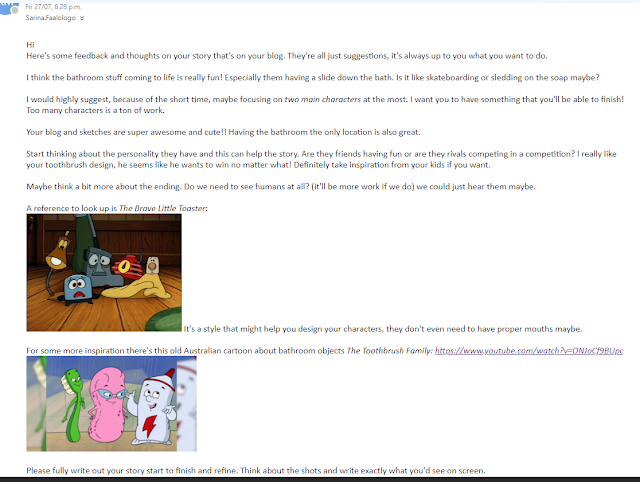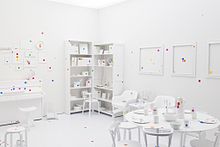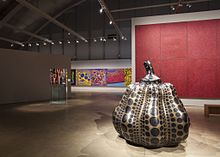"Kusama" redirects here. For the film director, see
Karyn Kusama.
Yayoi Kusama (
草間 彌生, Kusama Yayoi, born March 22, 1929) is a
Japanese contemporary artist who works primarily in
sculpture and
installation, but is also active in
painting,
performance,
film,
fashion,
poetry,
fiction, and other arts. Her work is based in
conceptual art and shows some attributes of
feminism,
minimalism,
surrealism,
Art Brut, pop art, and abstract expressionism, and is infused with
autobiographical,
psychological, and
sexual content. She has been acknowledged as one of the most important living artists to come out of
Japan.
[1]
Raised in
Matsumoto, Kusama trained at the Kyoto School of Arts and Crafts in a traditional Japanese painting style called
nihonga.
[2] Kusama was inspired, however, by American
Abstract Impressionism. She moved to New York City in 1958 and was a part of the New York
avant-garde scene throughout the 1960s, especially in the
pop-art movement.
[3] Embracing the rise of the
hippie counterculture of the late 1960s, she came to public attention when she organized a series of
happenings in which naked participants were painted with brightly colored
polka dots.
[4][5] Since the 1970s, Kusama has continued to create art, most notably installations in various museums around the world.
[6]
Biography[edit]
Early life: 1929-1949[edit]
Born in 1929 in
Matsumoto, Nagano into an
affluent family of
merchants who owned a
plant nursery and
seed farm,
[7] Kusama started creating art at an early age and began writing poetry at age 18. Her mother was apparently physically
abusive,
[8] and Kusama remembers her father as "the type who would play around, who would womanize a lot".
[7] The artist says that her mother would often send her to spy on her father's
extramarital affairs, which instilled within her a lifelong contempt for
sexuality, particularly the male body and the
phallus: "I don’t like sex. I had an obsession with sex. When I was a child, my father had lovers and I experienced seeing him. My mother sent me to spy on him. I didn’t want to have sex with anyone for years [...] The sexual obsession and fear of sex sit side by side in me."
[9]
When she was ten years old, she began to experience vivid
hallucinations which she has described as "flashes of light, auras, or dense fields of dots".
[10] These hallucinations also included
flowers that spoke to Kusama, and patterns in
fabric that she stared at coming to life, multiplying, and engulfing or expunging her,
[11] a process which she has carried into her artistic career and which she calls "self-obliteration".
[12] She was reportedly fascinated by the smooth white stones covering the bed of the river near her family home, which she cites as another of the seminal influences behind her lasting fixation on dots.
[13]
When Kusama was 13, she was sent to work in a military
factory where she was tasked with
sewing and fabricating
parachutes for the
Japanese army, then embroiled in
World War II.
[1] Discussing her time in the factory, she says that she spent her adolescence "in closed darkness" although she could always hear the
air-raid alerts going off and see American
B-29s flying overhead in broad daylight.
[1] Her childhood was greatly influenced by the events of the war, and she claims that it was during this period that she began to value notions of personal and creative freedom.
[13]
She went on to study
Nihonga painting at the Kyoto Municipal School of Arts and Crafts in 1948.
[14] Frustrated with this distinctly Japanese style, she became interested in the European and American
avant-garde, staging several
solo exhibitions of her paintings in Matsumoto and
Tokyo in the 1950s.
[15]
Early success in Japan: 1950–1956[edit]
By 1950, Kusama was depicting abstracted natural forms in watercolor,
gouache, and oil, primarily on paper. She began covering surfaces—walls, floors,
canvases, and later, household objects, and naked assistants—with the
polka dots that would become a trademark of her work.
The vast fields of
polka dots, or "infinity nets", as she called them, were taken directly from her hallucinations. The earliest recorded work in which she incorporated these dots was a drawing in 1939 at age 10, in which the image of a Japanese woman in a
kimono, presumed to be the artist's mother, is covered and obliterated by spots.
[16] Her first series of large-scale, sometimes more than 30 ft-long canvas paintings,
[17] Infinity Nets, were entirely covered in a sequence of nets and dots that alluded to hallucinatory visions.
In her 1954 painting
Flower (D.S.P.S), Kusama has said,
One day I was looking at the red flower patterns of the tablecloth on a table, and when I looked up I saw the same pattern covering the ceiling, the windows, and the walls, and finally all over the room, my body and the universe. I felt as if I had begun to self-obliterate, to revolve in the infinity of endless time and the absoluteness of space, and be reduced to nothingness. As I realized it was actually happening and not just in my imagination, I was frightened. I knew I had to run away lest I should be deprived of my life by the spell of the red flowers. I ran desperately up the stairs. The steps below me began to fall apart and I fell down the stairs straining my ankle.[18]
New York City: 1957–1972[edit]
After living in Tokyo and France, Kusama left Japan at the age of 27 for the United States. She has stated that she began to consider Japanese society "too small, too servile, too feudalistic, and too scornful of women."
[10] In 1957, she moved to
Seattle, where she had an exhibition of paintings at the
Zoe Dusanne Gallery.
[19] She stayed there for a year
[20] before moving on to New York City, following correspondence with
Georgia O'Keeffe in which she professed an interest in joining the limelight of the city, and sought O'Keeffe's advice.
[21] During her time in the US, she quickly established her reputation as a leader in the avant-garde movement and received praise for her work from the anarchist art critic
Herbert Read.
[22] In 1961 she moved her studio into the same building as
Donald Judd and sculptor
Eva Hesse; Hesse became a close friend.
[23] In the early 1960s Kusama began to cover items such as ladders, shoes and chairs with white phallic protrusions.
[24] Despite the micromanaged intricacy of the drawings, she turned them out fast and in bulk, establishing a rhythm of productivity which she still maintains. She established other habits too, like having herself routinely photographed with new work
[20] and regularly appearing in public wearing her signature bobbed wigs and colorful, avant-garde fashions.
[9]
A polka-dot has the form of the sun, which is a symbol of the energy of the whole world and our living life, and also the form of the moon, which is calm. Round, soft, colorful, senseless and unknowing. Polka-dots become movement ... Polka dots are a way to infinity.
“
”
—Yayoi Kusuma, in Manhattan Suicide Addict [25]
Since 1963, Kusama has continued her series of
Mirror/Infinity rooms. In these complex
infinity mirror installations, purpose-built rooms lined with mirrored glass contain scores of neon-colored balls, hanging at various heights above the viewer. Standing inside on a small platform, an observer sees light repeatedly reflected off the mirrored surfaces to create the illusion of a never-ending space.
[26] During the following years, Kusama was enormously productive, and by 1966 she was experimenting with room-size, freestanding installations that incorporated mirrors, lights, and piped-in music. She counted Judd and
Joseph Cornell among her friends and supporters. However, she did not profit financially from her work. Around this time, Kusama was hospitalized regularly from overwork, and O'Keeffe convinced her own dealer Edith Herbert to purchase several works in order to help Kusama stave off financial hardship.
[14]
In the 1960s, Kusama organized outlandish
happenings in conspicuous spots like
Central Park and the
Brooklyn Bridge, often involving
nudity and designed to protest the
Vietnam War. In one, she wrote an open letter to
Richard Nixon offering to have sex with him if he would stop the Vietnam war.
[17] Between 1967 and 1969 she concentrated on performances held with the maximum publicity, usually involving Kusama painting polka dots on her naked performers, as in the
Grand Orgy to Awaken the Dead at the MoMA (1969), which took place at the Sculpture Garden of the
Museum of Modern Art.
[24] During the unannounced event, eight performers under Kusama's direction removed their clothing, stepped nude into a fountain, and assumed poses mimicking the nearby sculptures by
Picasso,
Giacometti, and
Maillol.
[27]
In 1968, Kusama presided over the happening
Homosexual Wedding at the Church of Self-obliteration at 33 Walker Street in New York and performed alongside
Fleetwood Mac and
Country Joe and the Fish at the
Fillmore East in New York City.
[14] She opened naked painting studios and a gay social club called the
Kusama 'Omophile Kompany (kok).
[28]
In 1966, Kusama first participated in the
Venice Biennale for its 33rd edition. Her
Narcissus Garden comprised hundreds of mirrored spheres outdoors in what she called a "kinetic carpet". As soon as the piece was installed on a lawn outside the Italian pavilion, Kusama, dressed in a golden kimono,
[17] began selling each individual sphere for 1,200 lire (US$2), until the Biennale organizers put an end to her enterprise.
Narcissus Garden was as much about the promotion of the artist through the media as it was an opportunity to offer a critique of the mechanization and commodification of the art market.
[29]
During her time in New York, Kusama had a brief relationship with artist
Donald Judd. She then began a passionate, but platonic, relationship with the surrealist artist
Joseph Cornell. She was twenty-six years his junior—they would call each other daily, sketch each other, and he would send personalized collages to her. Their lengthy association would last until his death in 1972.
[30]
Return to Japan: 1973–1977[edit]
In 1973, Kusama returned to Japan in ill health, where she began writing shockingly visceral and surrealistic novels, short stories, and poetry. She became an art dealer, but her business folded after several years and in 1977 Kusama checked herself into the Seiwa Hospital for the Mentally Ill, where she eventually took up permanent residence. She has been living at the hospital since, by choice.
[31] Her studio, where she has continued to produce work since the mid-1970s, is a short distance from the hospital in
Shinjuku, Tokyo.
[32] Kusama is often quoted as saying: "If it were not for art, I would have killed myself a long time ago."
[33]
From this base, she has continued to produce artworks in a variety of media, as well as launching a literary career by publishing several novels, a poetry collection, and an autobiography.
[8] Her painting style shifted to high-colored acrylics on canvas, on an amped-up scale.
[34]
Revival: 1980s–present[edit]
Her organically
abstract paintings of one or two colors (the
Infinity Nets series), which she began upon arriving in New York, garnered comparisons to the work of
Jackson Pollock,
Mark Rothko, and
Barnett Newman. When she left New York she was practically forgotten as an artist until the late 1980s and 1990s, when a number of retrospectives revived international interest.
[35]
Following the success of the Japanese pavilion at the
Venice Biennale in 1993, a dazzling mirrored room filled with small pumpkin sculptures in which she resided in color-coordinated magician's attire, Kusama went on to produce a huge, yellow pumpkin sculpture covered with an optical pattern of black spots. The pumpkin came to represent for her a kind of alter-ego or self-portrait.
[36] Kusama's later installation
I'm Here, but Nothing (2000–2008) is a simply furnished room consisting of table and chairs, place settings and bottles, armchairs and rugs, however its walls are tattooed with hundreds of fluorescent polka dots glowing in the
UV light. The result is an endless infinite space where the self and everything in the room is obliterated.
[37]

Narcissus Garden (2009), Instituto Inhotim, Brumadinho, Brazil
The multi-part floating work
Guidepost to the New Space, a series of rounded "humps" in fire-engine red with white polka dots, was displayed in Pandanus Lake. Perhaps one of Kusama's most notorious works, various versions of
Narcissus Garden have been presented worldwide venues including Le Consortium, Dijon, 2000; Kunstverein Braunschweig, 2003; as part of the
Whitney Biennial in Central Park, New York in 2004; and at the
Jardin de Tuileries in Paris, 2010.
[38]
In her ninth decade, Kusama has continued to work as an artist. She has harkened back to earlier work by returning to drawing and painting; her work remained innovative and multi-disciplinary, and a 2012 exhibition displayed multiple acrylic-on-canvas works. Also featured was an exploration of infinite space in her
Infinity Mirror rooms. These typically involve a cube-shaped room lined in mirrors, with water on the floor and flickering lights; these features suggest a pattern of life and death.
[39]
In 2017, a 50-year retrospective of her work opened at the
Hirshhorn Museum in Washington, DC. The exhibit featured six
Infinity Mirror rooms, and is scheduled to travel to five museums in the US and Canada.
[40][41] On February 25, 2017, Kusama's
All the Eternal Love I Have for the Pumpkins exhibit, one of the six components to her
Infinity Mirror rooms at the Hirshhorn Museum, was temporarily closed for three days following damage to one of the exhibit's glowing pumpkin sculptures. The room, which measures 13 square feet (1.2 m
2) and is filled with over 60 pumpkin sculptures, is one of the museum's most popular attractions ever. Allison Peck, a spokeswoman for the Hirshhorn, said in an interview that the museum "has never had a show with that kind of visitor demand", with the room averaging over 8,000 visitors between its opening and the date of its temporary closing. While there were conflicting media reports about the cost of the damaged sculpture and how exactly it was broken, Allison Peck stated that "there is no intrinsic value to the individual piece. It is a manufactured component to a larger piece." The exhibit was reconfigured to make up for the missing sculpture, and a new one was to be produced for the exhibit by Kusama.
[42]
Also in 2017, the Yayoi Kusama Museum opened; it is in Tokyo and features her works.
[43]
























































